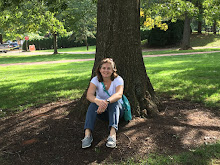We began with a simple exercise designed to encourage focus, concentration and non-verbal communication. Pairs were seated at a table with a sheet of paper and identical sets of blocks. Builders took turns building and following, with the only requirement being that they pair not speak - they were to use non-verbal communication to lead and follow.
We also discussed how a similar activity could be done "back to back" or with a partition to prevent seeing the partner's blocks. Then the challenge is to develop a workable and descriptive language for describing placement and interaction of pieces so the partner can replicate the design without seeing it.
Either way this activity improves focus and concentration while offering kids an opportunity to work collaboratively and take turns as leader and follower.
As we continued with our discussion and exploration of building materials in the classroom, there was a general consensus of the delight in bringing blocks to the table to offer each child a spot to build and a small group of blocks for building. As we spoke, participants changed and played with different designs, exploring balance, symmetry, layering and just having fun.
While many classrooms have a blocks center or class set of blocks used during play and exploration time, this bringing blocks to the table helps to make more transparent the great learning that is going on in building in a classroom. It allows the adults as well as the kids a chance to focus in on one material and the many things kids can do with blocks.
For our explorations, we continued with adding drawing as a way to reflect on our buildings. Each participant built a structure or design and then sketched this design with a pencil.
Reflecting afterward on the experience, the main description was "intense" - careful observation and representation of space and objects in drawing is intense - for adults and for kids. I think it is this intensity that I so enjoy observing when children draw what they build. Having built and manipulated the blocks first, they have an added felt knowledge of their building and a commitment to representing and saving their built idea on paper.
We also discussed teachers using drawing as a visual note-taking to record children's buildings. Time can be a constraint and most participants (myself included) use photography as it is quicker and easier. We discussed the important modeling that can happen if kids see adults drawing as a way of remembering and note-taking.
Often it seems adults hesitate to draw with and around kids for fear of influencing or intimidating children with their greater skill. At the same time when the drawing is purposeful and a real act of observation it serves as a great model for kids of ways to record and remember. Just as adults taking notes doesn't shut down kids' desire to write, adults taking visual notes doesn't have to shut down kids' desire to draw. It is really about the adult being engaged in his or her own process and in that way modeling engagement for the child.
The following article presents some great examples of the advantages of teacher visual note-taking of children's block buildings:
We also discussed using blocks and building to access things that kids (or adults) may know with their hands and their senses but not yet be ready to explain in words. Often children may have knowledge and ability with materials that is greater than their language development. Learning can be frustrating not because they don't understand how to DO but because they don't understand how to represent on paper and tell about it. One way to build on these children's strengths is to focus on what they build and work toward the linguistic and symbolic communication by asking how they could represent or give directions to another builder to replicate what they have done. This act of recording and remembering can help move from the in the hands knowledge to linguistic and symbolic communication of that knowing. One book that describes this process and the hand-brain learning connection quite well is The Hand by Frank R. Wilson.
Our block building explorations throughout the evening were full of joy and excitement and many great stories of the strengths kids show in building in the classroom.
Here are a few stories of building and drawing in the studio lab at Art at the Center for further examples of the rich explorations that take place with building materials:


No comments:
Post a Comment